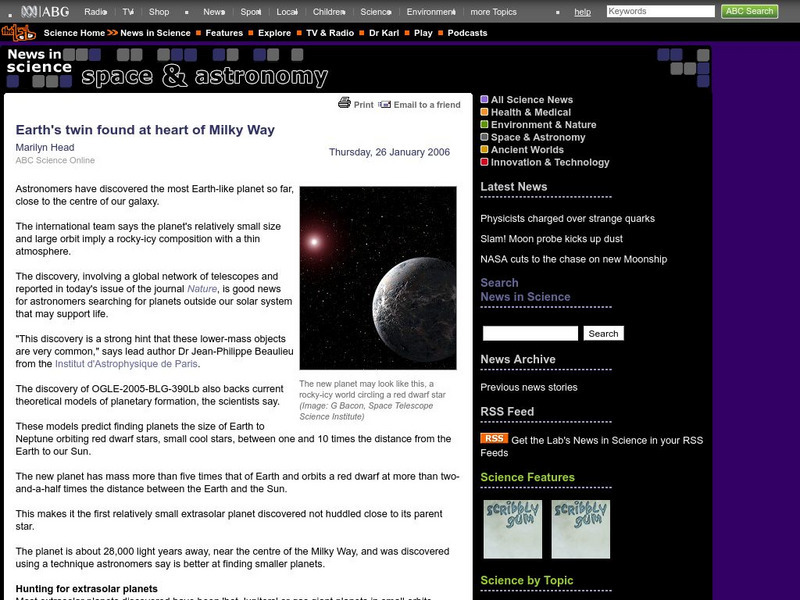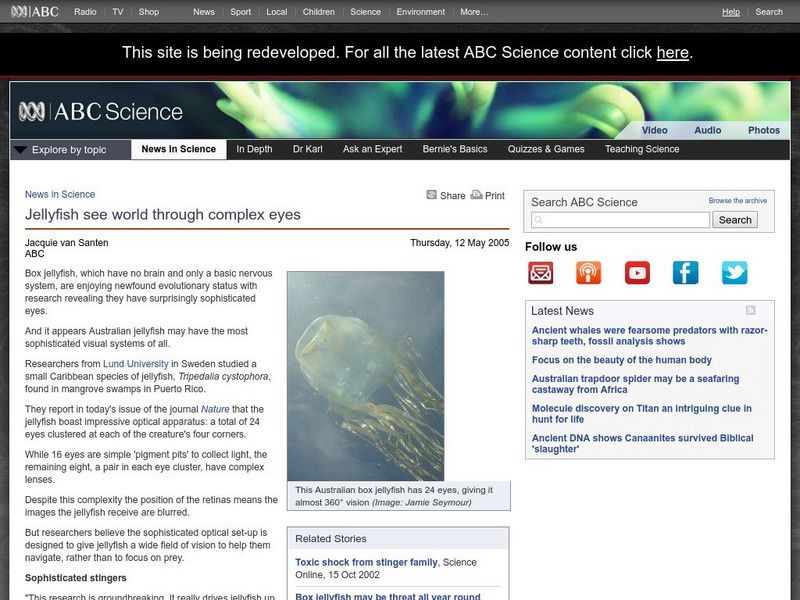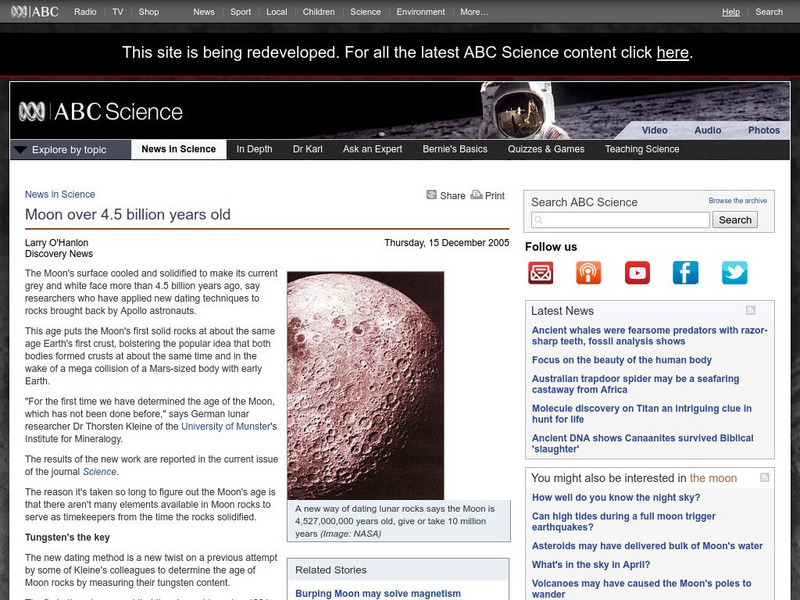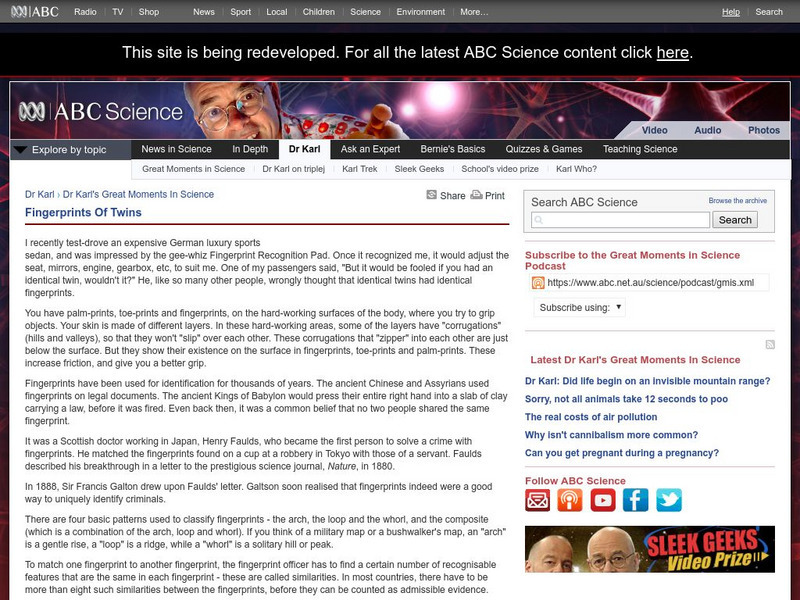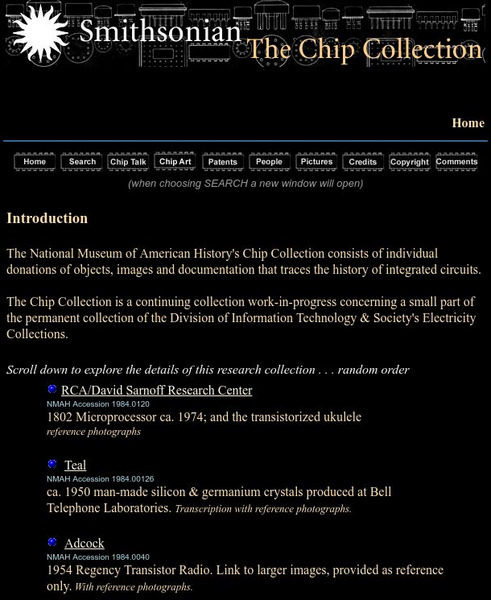Other
Rmc Research Corporation: Kristallnacht
This is a reading comprehension lesson plan featuring Kristallnact "Night of the Broken Glass." Middle school students will have an opportunity to learn through this interdisciplinary activity.
University Corporation for Atmospheric Research
Ucar: Field Projects: Science in Action
In this activity, students gather information about atmospheric scientific field projects in order to understand how a research question about the Earth system can be answered by collecting data using many different research platforms...
University Corporation for Atmospheric Research
Ucar: University Corporation for Atmospheric Research
Find out more about oceanography from space research.
Australian Broadcasting Corporation
Australian Broadcasting Corporation: News in Science: Bats Use Compass for Long Trips
From ABC News in Science, this article discusses research connected to the tracking of several big brown bats as they headed back to their homes. The experiment utilized several magnetic fields in attempts to disrupt the paths taken by...
Australian Broadcasting Corporation
Australian Broadcasting Corporation: News in Science: Antarctic Glaciers Picking Up Speed
From ABC News in Science, this article discusses scientific research connected to the rise in sea level because of fast-moving glaciers in the Antarctic.
Australian Broadcasting Corporation
Australian Broadcasting Corporation: News in Science: Antarctic Reveals Treasure Trove of Life
From ABC News in Science, Maggie Fox's article examines research connected to the various species of life discovered in the "dark waters around Antarctica." These findings include sponges, crustaceans, and new worms.
Australian Broadcasting Corporation
Australian Broadcasting Corporation: News in Science: Astronomers Seek Life at End of Rainbow
From ABC News in Science, Marilyn Head's article explores the possibility entertained by several researchers that the key to discovering life beyond Earth (or habitable planets) is in studying rainbows.
Australian Broadcasting Corporation
Australian Broadcasting Corporation: News in Science: Chimp Dna Sheds Light on Humanity
From ABC News in Science, Richard Ingham's article sheds light on scientific research comparing and contrasting the DNA of Chimpanzees with the DNA of humans.
Australian Broadcasting Corporation
Australian Broadcasting Corporation: News in Science: Crabs Change Color
From ABC News in Science, Stephen Pincock's article, "Crabs change color to escape hungry birds," focuses on research conducted on tiny fiddler crabs and their defense mechanisms.
Australian Broadcasting Corporation
Australian Broadcasting Corporation: News in Science: Dogs Prefer Winners
From ABC News in Science, Jennifer Viegas's article deals with social behavior of dogs and current research suggesting that they gravitate toward "winners." When they observe other animals or animal-human interaction, they go towards the...
Australian Broadcasting Corporation
Australian Broadcasting Corporation: News in Science: Earth's Twin Found at Heart of Milky Way
From ABC News in Science, Marilyn Head's article centers on research behind the discovery of the planet in the Milky Way which most closely resembles the planet Earth.
Australian Broadcasting Corporation
Australian Broadcasting Corporation: News in Science: Glaciers Melting Faster as Planet Warms
From ABC News in Science, this article discusses climate change research which suggests that the worldwide issue of melting glaciers is a clear sign of changing climate conditions.
Australian Broadcasting Corporation
Australian Broadcasting Corporation: News in Science: Jellyfish See World Through Complex Eyes
From ABC News in Science, Jacquie van Santen's article explores research backing the complexity of the eyes in jellyfish, which, according to scientists, will place them higher on the evolutionary ladder.
Australian Broadcasting Corporation
Australian Broadcasting Corporation: News in Science: Milky Way Is Many Tentacled Beast
From ABC News in Science, Larry O'Hanlon's article discusses research connected to the size of the Milky Way Galaxy. The article suggests that the galaxy, instead of being a neat spiral, stretches out through a series of arms.
Australian Broadcasting Corporation
Australian Broadcasting Corporation: News in Science: Moon Over 4.5 Billion Years Old
From ABC News in Science, Larry O'Hanlon's article uses research connected to the element tungsten-182 found on the Moon to develop theories as to the age of the Moon and the formation of the Moon.
Australian Broadcasting Corporation
Australian Broadcasting Corporation: News in Science: Neptune Nabbed Its Moon
From ABC News in Science, Irene Klotz's article discusses research related to the possibility of Neptune having "nabbed" its moon, Triton, from some passing sister planets.
Australian Broadcasting Corporation
Australian Broadcasting Corporation: News in Science: Overfishing May Wipe Seafood Off Menu
From ABC News in Science, Deborah Zabarenko's article predicts, based on scientific research, the destruction of the fishing community by 2048 based on overfishing.
Australian Broadcasting Corporation
Australian Broadcasting Corporation: News in Science: Pigeons Smell Their Way Home
From ABC News in Science, Rossella Lorenzi's article discusses the research of Italian scientists who may have discovered the secret to the pigeon's legendary "homing" capabilities.
Australian Broadcasting Corporation
Australian Broadcasting Corporation: News in Science: Saturn's Day Lengthens by Minutes
From ABC News in Science, this article discusses research connected to Saturn's spinning and the resulting lengthening of Saturn's days.
Australian Broadcasting Corporation
Australian Broadcasting Corporation: News in Science: Sea Urchins Are Part Human
From ABC News in Science, this article discusses research connected to the possibility that despite their qualities of brainless, limbless, and invertebrates, sea urchins are actually similar to humans.
Australian Broadcasting Corporation
Australian Broadcasting Corporation: News in Science: Fingerprints of Twins
If you had an identical twin would you have the same set of fingerprints? Site uncovers the answer by researching the science behind fingerprints.
Smithsonian Institution
National Museum of American History: Chip Collection
The National Museum of American History's Chip Collection consists of individual donations of objects, images and documentation that traces the history of integrated circuits. Scroll down to explore the details of this unique research...
Intel Corporation
Intel: Fractions Made Visual
Students learn the importance of math accuracy and, more specifically, that knowing how to add, subtract, multiply, and divide fractions make life easier for everyone. To help students come to this understanding, they are assigned to a...
Council for Economic Education
Econ Ed Link: Business Ownership: How Sweet It Can Be!
In this lesson, young scholars research the three basic types of business organization: sole proprietorships, partnerships, and corporations. Considering the advantages and disadvantages of each, they function as consultants offering...









